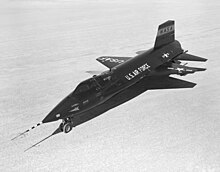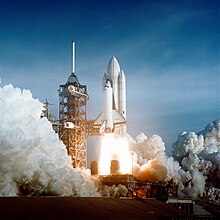Joe Henry Engle
| Joe Engle | |
|---|---|

|
|
| Country: | United States |
| Organization: | NASA |
| selected on | April 4, 1966 ( 5th NASA Group ) |
| Calls: | 2 space flights |
| Start of the first space flight: |
November 12, 1981 |
| Landing of the last space flight: |
3rd September 1985 |
| Time in space: | 9d 8h 30min |
| retired on | November 30, 1986 |
| Space flights | |
Joe Henry Engle (born August 26, 1932 in Chapman , Dickinson County , Kansas ) is a retired American astronaut .
Engle is married and has two grown children. He's still an avid aviator today.
Start of career
Engle grew up in a rural area in the state of Kansas. After finishing school, he studied aerospace engineering at the University of Kansas . After successfully completing his studies in 1955, he was trained as an officer in the Air Force . In 1957 he began his pilot training and then served at George Air Force Base in California . At Edwards Air Force Base , he completed training as a test pilot . From June 1963 he was involved in the testing of the X-15 experimental aircraft . In three of his 15 flights with this rocket-propelled aircraft, he reached an altitude of more than 50 miles (about 80 kilometers). According to the Air Force definition, he was already considered an astronaut when he was selected in 1966 with NASA's fifth astronaut group .
Astronaut activity
In 1966 the Gemini program was already in full swing. The new astronauts were assigned to the Apollo program straight away.
2TV-1
Engle was one of the three astronauts who carried out one of the most important tests of the new Apollo spacecraft in the summer of 1968 , which was supposed to prove its practicality. Together with Joe Kerwin and Vance Brand , Engle was supposed to subject the spaceship to a long-term test of a week in a vacuum chamber. A positive result of this test was absolutely necessary for the start of Apollo 7 . From June 16, 1968, Kerwin, Brand and Engle spent seven days in the Apollo command module 2TV-1, which corresponded to that of Apollo 7 but was not suitable for space flight. Except for the lack of weightlessness, this test was a realistic simulation of an Apollo mission in earth orbit.
Apollo 10 (support team)
In November 1968, Engle was assigned to the Apollo 10 support team. During the flight in May 1969 he also worked as a liaison officer ( Capcom ).
Apollo 14 (substitute team)
On 6 August 1969, shortly after the successful moon landing by Apollo 11 , Engle as a substitute for was Ed Mitchell , pilot of the lunar module of Apollo 14 nominated. This backup crew also included Commander Eugene Cernan as substitute for Alan Shepard , the first American in space , and Ron Evans as the pilot of the Apollo command module .
It was actually considered to have the substitute Engle fill in, since Ed Mitchell planned experiments on psychic phenomena during the mission . In order not to separate the well-rehearsed teams, this change was not made. Mitchell's private experiments yielded no useful results.
Apollo 17 (replaced)
On August 13, 1971, shortly after the Apollo 15 flight , NASA announced the crew for the Apollo 17 mission . According to the schedule, it would have been the turn of the Apollo 14 substitute team to move up to the main team. So the nomination of Eugene Cernan as commander and Ron Evans as pilot of the Apollo command module came as no surprise. Instead of Joe Engle, however, Harrison "Jack" Schmitt from the Apollo 15 backup team was assigned to pilot the lunar module. Schmitt was one of the science astronauts selected by NASA in 1965, none of whom had yet been deployed. Under pressure from NASA scientists, Schmitt was given preference over Engle. At this point the flights Apollo 18 and Apollo 19 had already been canceled, so it was clear that Apollo 17 would be the last flight to the moon for a long time.
Preparation of the space shuttle flights
After narrowly missing a flight to the moon, Engle stayed with NASA anyway. He did not participate in the American space station Skylab project or the Apollo-Soyuz project . Rather, he immediately turned to the shuttle program. Here he was able to contribute his experience from the flights with the X-15, which had also penetrated into space and then landed like the shuttle without propulsion.
He was the commander of one of the two teams that examined the behavior of the space shuttle on approach as part of the ALT ( Approach and Landing Tests ) program between February and November 1977.
STS-1 (substitute team)
On the first flight of the STS-1 shuttle , he was in command of the reserve crew.
STS-2
On November 12th, 1981, after 16 years of waiting, he started his first orbital flight as commander with STS-2 . Engle was the sixth and last NASA astronaut who was given command of a multi-person spacecraft on its first flight. Richard Truly accompanied him as a pilot on this flight with Columbia . It was the first manned flight in which the spacecraft was reused: the Columbia space shuttle had already been used on the STS-1 mission.
The five-day mission was shortened by almost three days because one of the three fuel cells used to produce energy and drinking water failed. Nevertheless, 90% of the planned program was completed. For the first time, the Canadian manipulator arm was also successfully tested in its various operating modes. With the payload in the cargo hold of the shuttle, explorations of the natural resources , the climate , the ocean and the weather were carried out. On re-entry and landing, Engle flew the shuttle manually and not using the autopilot - for the first and only time during the entire shuttle program. This should be used to check the stability and behavior of the shuttle under heavy loads.
After his first space flight, Engle worked for some time in the administration of NASA. After just a few months, however, he had himself restored to the status of an active astronaut and was preparing for his second space flight.
STS-51-I
With the space shuttle Discovery he started on August 27, 1985 as commander of the STS-51-I mission . It was the 20th space shuttle mission and the sixth space shuttle Discovery flight. The five-man crew put three communications satellites into orbit. In addition, a defective satellite launched on the STS-51-D mission was captured, repaired and then relocated. These were extravehicular activities of a total of 11 hours and 27 minutes duration necessary.
Joe Engle was involved in investigating the 1986 Challenger disaster . He worked as a consultant for NASA until the 1990s.
Honors
For his work in the X-15 project he was awarded the USAF Astronaut Wings in 1964. A selection of other honors:
- USAF Distinguished Flying Cross (1964 and 1978)
- AIAA Pioneer of Flight Award (1965)
- NASA Exceptional Service Medal o NASA Special Achievement Award
- AIAA Haley Space Flight Award for 1980
- NASA Distinguished Service Medal
- Kansan of the Year, 1981
- USAF Distinguished Service Medal
In 2000, Joe Engle was inducted into the National Aviation Hall of Fame .
The asteroid (8028) Joeengle , discovered in 1991, was named after him.
See also
swell
- Eugene Cernan and Don Davis, The Last Man on the Moon , St. Martin's Press, 1999, ISBN 0312199066
- Andrew Chaikin, A Man on the Moon , Penguin Books, 1994, ISBN 0140241469
Web links
- Short biography of Joe Henry Engle at spacefacts.de
- NASA biography of Joe Henry Engle (PDF)
- Biography of Joe Henry Engle in the Encyclopedia Astronautica (English)
- National Aviation Hall of Fame: Full Biography (English)
| personal data | |
|---|---|
| SURNAME | Engle, Joe Henry |
| BRIEF DESCRIPTION | American astronaut |
| DATE OF BIRTH | August 26, 1932 |
| PLACE OF BIRTH | Chapman , Kansas |



